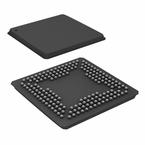Introduction
●This section describes the main features of the TMS320VC5410 digital signal processor (DSP), lists the pin assignments, and describes the function of each pin. This data manual also provides a detailed description section, electrical specifications, parameter measurement information, and mechanical data about the available packaging.
●Description
●The TMS320VC5410 fixed-point, digital signal processor (DSP) (hereafter referred to as the 5410 unless otherwise specified) is based on an advanced modified Harvard architecture that has one program memory bus and three data memory buses. This processor provides an arithmetic logic unit (ALU) with a high degree of parallelism, application-specific hardware logic, on-chip memory, and additional on-chip peripherals. The basis of the operational flexibility and speed of this DSP is a highly specialized instruction set.
●Features
●• Advanced Multibus Architecture With Three Separate 16-Bit Data Memory Buses and One Program Memory Bus
●• 40-Bit Arithmetic Logic Unit (ALU) Including a 40-Bit Barrel Shifter and Two Independent 40-Bit Accumulators
●• 17- × 17-Bit Parallel Multiplier Coupled to a 40-Bit Dedicated Adder for Non-Pipelined Single-Cycle Multiply/Accumulate (MAC) Operation
●• Compare, Select, and Store Unit (CSSU) for the Add/Compare Selection of the Viterbi Operator
●• Exponent Encoder to Compute an Exponent Value of a 40-Bit Accumulator Value in a Single Cycle
●• Two Address Generators With Eight Auxiliary Registers and Two Auxiliary Register Arithmetic Units (ARAUs)
●• Data Bus With a Bus Holder Feature
●• Extended Addressing Mode for 8M × 16-Bit Maximum Addressable External Program Space
●• 64K x 16-Bit On-Chip RAM Composed of:
● -- Four Blocks of 2K × 16-Bit On-Chip Dual-Access Program/Data RAM
● -- Seven Blocks of 8K × 16-Bit On-Chip Single-Access Program/Data RAM
●• 16K × 16-Bit On-Chip ROM Configured to Program Memory
●• Single-Instruction-Repeat and Block-Repeat Operations for Program Code
●• Block-Memory-Move Instructions for Better Program and Data Management
●• Instructions With a 32-Bit Long Word Operand
●• Instructions With Two- or Three-Operand Reads
●• Arithmetic Instructions With Parallel Store and Parallel Load
●• Conditional Store Instructions
●• Fast Return From Interrupt
●• On-Chip Peripherals
● -- Software-Programmable Wait-State Generator and Programmable Bank-Switching
● -- On-Chip Programmable Phase-Locked Loop (PLL) Clock Generator With Internal Oscillator or External Clock Source
● -- One 16-Bit Timer
● -- Six-Channel Direct Memory Access (DMA) Controller
● -- Three Multichannel Buffered Serial Ports (McBSPs)
● -- 8-Bit Enhanced Parallel Host-Port Interface (HPI8)
● -- Enhanced External Parallel Interface (XIO2)
●• Power Consumption Control With IDLE1, IDLE2, and IDLE3 Instructions With Power-Down Modes
●• CLKOUT Off Control to Disable CLKOUT
●• On-Chip Scan-Based Emulation Logic, IEEE Std 1149.1† (JTAG) Boundary Scan Logic
●• 144-Pin Low-Profile Quad Flatpack (LQFP) (PGE Suffix)
●• 176-Ball MicroStar BGA™ (GGW Suffix)
●• 10-ns Single-Cycle Fixed-Point Instruction Execution Time (100 MIPS)
●• 3.3-V I/O and 2.5-V Core Supply Voltages


